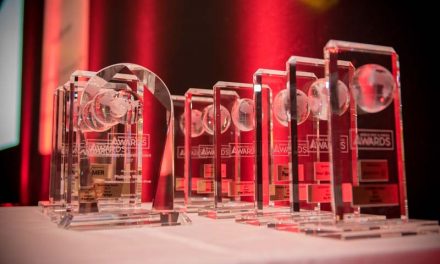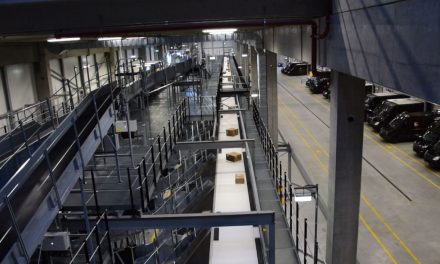
Business Express: Delivering on a promise
BUSINESS EXPRESS , the delivery subsidiary of the Littlewoods Group (Littlewoods Stoics, Index Stores. Index Extra Catalogue and Littlewods Catalogues) was handling up to 400,000 parcels a day through the hub during the peak pre-Christmas period. The system is housed in a 39,000 sq m building within a large marshalling area. It handles both bulk products in callous and small parcelled items. At present, about 80 percent of the traffic is from Littlewoods and the remainder from third party clients of Business Express, which is contracted to provide delivery services for such major retailers and home shopping specialists as Boots, WH Smith On-Line, M&M Sports, the White Company, Lands End and Thorntons. Third patty contracts are Ofl course to grow rapidly. Mick Janicki, managing director of Business Express, predicts that these are scheduled to reach 40 percent of transactions within three years. Business Express ranks as one of the UK’s ‘big three’ home delivery specialists (alongside Consignia and White Arrow), though .Janicki says, "We do not strive to become the largest. The emphasis is on providing quality innovative services.”
There is full integration from the time an order is placed to its despatch to one of 33 distribution cent res for final delivery. Orders from Littlewoods customers are processed electronically from three call centres within seconds of confirmation and downloaded ((the appropriate warehouses for picking. The warehouse for textiles and clothing is a short distance from the sorting hub and is linked by a conveyor system which feeds directly into the centre. Other products and those from third-party clients of Busines.s Express are delivered by trailer.
Warehouse system
Pick tours are automatically raised by a central computer and instructions given to warehouse staff via hand-held radio frequency terminals. Barcoded labels are produced at this point. Individual items from the Shaw warehouse travel along the conveyor in tote boxes to a carousel which deposits them at the appropriate collation and bagging points for final parcel labelling and loading into a Business Express line haul vehicle. Where there are two or more items in an order, these are identified by barcode readers to be combined at the same bagging point.
Products arriving by I railer are unloaded on to conveyors which extend into the vehicle. They pass through readers on to individual tip trays on a second carousel. Each tray allocates itself to a helical chute, sliding its contents to despatch handling points.
There is a degree of manual handling for large cartons (such as those containing TV sets) by staff’ using hand-held readers. All the other barcode reading points have both side and overhead readers which register and direct each item as it passes. On isolated occasions when fixed readers fail to pick up on an item it is momentarily halted for a hand reader to be used.
There are six main infeed points for trailers and ten feeds directly from the Littlewoods warehouse, giving 16 points at which goods are simultaneously inducted into the sorting system. In addition, there are eight bays for the manual handling of large cartons. Goods are despatched through 34 outfeed points (one for cacti of the distribution centres plus one ‘spare’).
IT nfrastructure
The main computing power which controls the system is based remotely at the Littlewoods headquarters in Liverpool. Two powerful Sun E10000 Starfire computers are employed, one continuously monitoring the other. In the event of a major failure by one computer the other will take over within six minutes, A further precaution is that these are housed in separate parts of the building.
There is similar back-up redundancy in the data transfer, with two separate 32 megabyte lines, “We have even gone (town to resilience levels whereby the communicat ion lines enter the sorting centre at opposite ends of the building,” explains David Hallett. Littlewoods Group IT l)irector. ‘At no point in the rouleing of these lines do theygo through the same exchange.”
Oracle-based warehouse management system software from Torex Retail integrates the individual elements of the sorting centre. The
main sort system hardware was sourced from Vanderlande Industries.
The systems which bring the parcels into the centre are provided by
Cleco, which also supplied a carton bulk storage system for another
Littlew ods warehouse near.by
The new installations at the hub have been accompanied by a further £8 million invest ment in a full track and trace system throughout the delivery chain. This is based on the same Sun computers in Liverpool, written in Oracle by Symbol and employing hand-held terminals and scanners supplied by that company.
In addition, lien isa reverse system for receiving and examining returned goods and restoring them to stock. About a third of clothing items ordered are sent back and it is critical to success in the home shopping market to provide customers with an effiient returns service.
“It should be the same as shopping in the high street. being able to try on different garments before making a choice,” says Mick Janicki. ‘Many of the new dot corn companies failed to take this into account to their detriment. Our responsibility is making home shopping an enjoyable experience with a quality service. This includes making it easy for the customer to have unwanted items c llected ed and for the return to he credited quickly back to the customer's account
He notes rising exj)e(tati ns by home sh ppers. “An acceptable delivery level two years ago was three to five (lays.” he comments. “w the requirement is 48 or 24 hours.” In fact, the majority
of Business Express deliveries are in 24 hours and he says the time is approaching when this will become standard.
He is examining the potential for offering opt ions of morning, afternoon, evening and weekend deliveries. At present, about 70
percent of deliveries are made in the morning. The incidence of
'carding' (where a contact card is left in the letterbox alter two failures
t deliver through the recipient not being at home) has been reduced to
3.5 percent. This as a result of enabling customers to nominate
alternative locations at which to leave parcels.
Mick Janicki is also keeping an eye on proposals for the installation of’ secure drop-boxes outside homes. He says, “potentially, it is a fine concept hut there are questions that need to he answered. For instance, who will pay for them, will they be affordable, will people want such
containers attached to their houses and how do you deal with the security issues which could arise from multi-use. “Business Express is currently assessing collection and drop off point service providers and will shortly announce its choice of partner.
“If satisfactory answers are found, it could change the world of home delivery,” he predicts. "We could deliver at night with quiet electric trucks as well as during the (lay.
L king ahead, Business Express has a three-year expansion plan in which the creation of a sec nd hill) in the Midlands is contemplat ed. ‘this will support Business Express growth plan and further enhance its service offering to customers.












